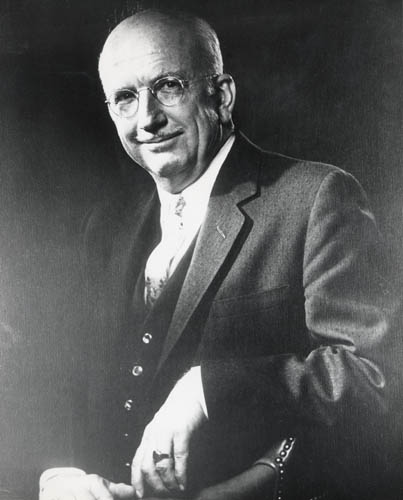By chance, I ran across a reference to a paper of J Barkey Rosser and it brought back fond memories of days long ago when I would browse the stacks in the math dept library at the University of Washington in Seattle. I remember finding papers describing number-theoretic computations of Rosser and Schoenfeld. I knew nothing about Rosser. Was he a number theorist?

J. Barkley Rosser, taken at Math meeting in Denver
Here’s all I could glean from different sources on the internet:
J. Barkley Rosser was born in Jacksonville, Florida in 1907. He earned both his Bachelor of Science (1929) and his Master of Science (1931) from the University of Florida. Both degrees were in physics. He obtained his Ph.D. in mathematics (in fact, mathematical logic) from Princeton University in 1934, under the supervision of Alonso Church. After getting his Ph.D., Rosser taught at Princeton, Harvard, and Cornell and spent the latter part of his career at the University of Wisconsin-Madison. As a logician, Rosser is known for his part in the Church-Rosser Theorem and the Kleene–Rosser Paradox in lambda calculus. Moreover, he served as president of the Association for Symbolic Logic. As an applied mathematician, he served as president of the Society of Industrial and Applied Mathematics (otherwise known as SIAM). While at the University of Wisconsin-Madison, he served as the director of the U.S. Army Mathematics Research Center. He continued to lecture well into his late 70s, and passed away at his home in Madison in 1989. He has a son, J. Barkley Rosser Jr, who’s an economist at James Madison University.
What about Schoenfeld?

Lowell Schoenfeld spent his early years in New York City, graduating Cum Laude from the College of the City of New York in 1940. He went on to MIT to earn a Master’s. He received his Ph.D. in 1944 from the University of Pennsylvania under the direction of Hans Rademacher. (During his years in graduate school, he seems to have worked for the Philadelphia Navy Yard as well, writing reports on aircraft navigational computers.) After positions at Temple University and Harvard, he moved to the University of Illinois, where he met his future wife. He met Josephine M. Mitchell when she was a tenured Associate Professor and he was an untenured Assistant Professor. After they married, the University would no longer allow Mitchell to teach, so the couple both resigned their positions and eventually settled at Pennsylvania State University. They spent about 10 years there but in 1968 the couple moved to the University of Buffalo, where they remained until their retirements in the 1980s.
As far as I can tell, these are the papers they wrote together, all in analytic number theory:
[1] Rosser, J. Barkley; Schoenfeld, Lowell. “Approximate formulas for some functions of prime numbers”. Illinois J. Math. 6 (1962), no. 1, 64–94.
[2] Rosser, J. Barkley; Schoenfeld, Lowell; J.M. Yohe. “Rigorous Computation and the Zeros of the Riemann Zeta-Function,” 1969
[3] Rosser, J. Barkley; Schoenfeld, Lowell. “Sharper Bounds for the Chebyshev Functions and
” Mathematics of Computation Vol. 29, No. 129 (Jan., 1975), pp. 243-269
[4] Rosser, J. Barkley; Schoenfeld, Lowell. “Approximation of the Riemann Zeta-Function” 1971.
I haven’t seen a copy of the papers [2] and [4] in years but I’m guessing these are what I looked at as a teenager in Seattle, years ago, wandering through the stacks at the UW.
Rosser also wrote papers on topics in recreational mathematics, such as magic squares. Two such papers were co-written with R.J. Walker from Cornell University, who’s more well-known for his textbook Algebraic Curves:
Rosser, Barkley; Walker, R. J. “The algebraic theory of diabolic magic squares,” Duke Math. J. 5 (1939), no. 4, 705–728
Rosser, Barkley; Walker, R. J. “On the transformation group for diabolic magic squares of order four,” Bull. Amer. Math. Soc. 44 (1938), no. 6, 416–420.
Diabolic magic squares, also called pan-diagonal magic squares, are squares of integers
whose rows all add to a constant C, whose columns all add to C, whose diagonals both add to C, and whose “broken diagonals” all add to C. An example was given by the German artist Albrecht Durer in the 1514 engraving called Melencolia I: (where C=34):

I wish I knew more about this number-theoretic side of Rosser. He’s a very interesting mathematician.
You must be logged in to post a comment.